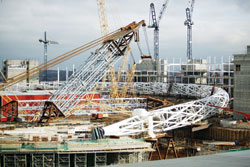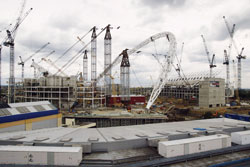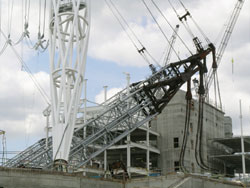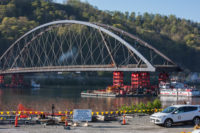 |
 |
 |
| SLOW RISE After assembly in near-flat position (top), arch was jacked using pivoting towers and guys (middle), slightly beyond vertical into final position, when jacking cables lost tension (above). (Photos top and center courtesy of Wembley National Stadium Ltd.; bottom by Peter Reina for ENR) |
Starting in late May, the arch lift was delayed by several weeks, in part because of repairs to faulty welds, according to the main contractor. Every weld on the arch is nondestructively tested...because the arch is such a critical element, says David Watkins, site manager for Multiplex Constructions U.K. Ltd., London.
The arch is intended to become the worlds greatest landmark for sports, says Mark Palios, chief executive of the Football Association, owner of operator Wembley National Stadium Ltd.
Creating an iconic structure was among the aims of the jobs lead architect Foster & Partners, London. But the arch also will support more than 4.5 hectares of roof on the north and south sides of the seating bowl, plus retractable panels on the east and west ends. The center of the square doughnut roof, over the grass field, will be open to weather.
No single element of the roof is novel, according to Mike Barker, a director of London-based Mott MacDonald, part of the design team. But the combination of components is impressive, he adds.
Straddling the north side of the 90,000-seat stadium, the arch will support a fixed cable net roof over the north seats. From the roofs edge, six trusses will span some 220 m to perimeter supports on the south side of the bowl, to support the south roof section. In 15 minutes, panels stored on the south roof can be slid mechanically over east and west ends.
|
Forming part of a circular arc, the arch is a 7.4-m-dia tube with lattice walls and numerous circular stiffening diaphragms. It is made of over 500 tube steel sections, about 45 cm in diameter, criss-crossing between the diaphragms.
Under a $110-million roof subcontract, Cleveland Bridge U.K. Ltd. fabricated arch sections at its Darlington base in northeast England. Starting last fall, Cleveland assembled 90-tonne sections in sheds on Wembleys field, and welded them together into the arch. The assembled arch lay almost flat with its ends projecting toward end supports that come up from the almost-circular concourse roof surrounding the bowl.
Pivoting on two supports, the arch was pulled during recent weeks by 20 strand jacks, with their cables passing over five steel pivoting towers. Around mid-June, the arch had passed beyond vertical and continued a few more degrees under gravity,...
trand jacks with 12,000 tonnes of pulling power have just raised a 1,750-tonne arch to be the main roof support for the U.K.s new national soccer stadium. Claimed as the worlds longest roof structure, Wembley Stadiums 315-meter-span arch in London will continue pivoting to its 133-m final height this week.

Post a comment to this article
Report Abusive Comment